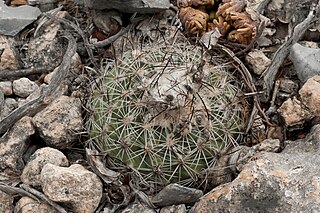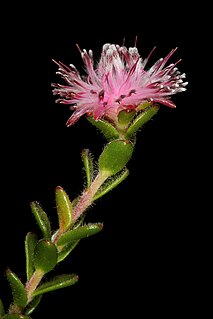
Lactuca, commonly known as lettuce, is a genus of flowering plants in the daisy family, Asteraceae. The genus includes at least 50 species, distributed worldwide, but mainly in temperate Eurasia.

Aegilops bicornis is a species in the family Poaceae native to Palestine and the Levant.

Aegilops crassa is an ornamental plant in the family Poaceae. It is referred to by the common name Persian goatgrass. It is native to Afghanistan, Iran, Iraq, Kazakhstan, Kyrgyzstan, Lebanon, Palestine, Syria, Tajikistan, Transcaucasia, Turkey, Turkmenistan, and Uzbekistan.
Aegilops kotschyi is a member of the grass family, Poaceae, native to the Levant.
Tapura letestui is a species of plant in the Dichapetalaceae family. It is found in the Republic of the Congo and Gabon.

Turbinicarpus saueri is a species of plant in the family Cactaceae.

Turbinicarpus schmiedickeanus is a species of plant in the family Cactaceae.
Baphiopsis parviflora is an African species of flowering plants in the legume family, Fabaceae. It belongs to the subfamily Faboideae. It is the only member of the genus Baphiopsis. It was traditionally assigned to the tribe Swartzieae; however, recent molecular phylogenetic analyses reassigned Baphiopsis parviflora into the Baphieae tribe.

Protea intonsa, also known as the tufted sugarbush, is a flowering plant of the genus Protea within the family Proteaceae, endemic to South Africa, where it is distributed from the eastern Swartberg and Kammanassie Mountains to the Baviaanskloof mountains. In Afrikaans it is known as klossie-suikerbos.
Chieniodendron is a genus of plant in the Annonaceae family. It has only one species Chieniodendron hainanense native to mainland China and Hainan. It is threatened by habitat loss.
Paranomus adiantifolius, the hairy-style sceptre, is a flower-bearing shrub that belongs to the genus Paranomus and forms part of the fynbos. The plant is native to the Western Cape, South Africa.
Diastella buekii, the Franschhoek silkypuff, is a flower-bearing shrub that belongs to the genus Diastella and forms part of the fynbos. The plant is native to the Western Cape and occurs in the Franschhoek and Wemmershoek valleys. The shrub is flat and grows only 15 cm tall and bears flowers from August to November.

Diastella divaricata is a flower-bearing shrub that belongs to the genus Diastella and forms part of the fynbos. The plant is native to the Western Cape and is found on the Cape Peninsula south of the Silvermine Nature Reserve. The shrub is flat and grows only 50 cm high but 3 m in diameter and flowers throughout the year without an obvious peak.
Diastella myrtifolia, the Tulbagh silkypuff, is a flower-bearing shrub that belongs to the genus Diastella and forms part of the fynbos. The plant is native to the Western Cape and is found in the Groot Winterhoek. The shrub is erect to semi-erect with mat-shaped spreading branches.

Diastella proteoides, the Flats silkypuff, is a flower-bearing shrub that belongs to the genus Diastella and forms part of the fynbos. The plant is native to the Western Cape and occurs on the Cape Flats from Tokai to Malmesbury and Eerste River. The shrub is flat and grows only 50 cm high but 3 m in diameter and flowers throughout the year with the peak from July to February.
Diastella thymelaeoides is a flower-bearing shrub that belongs to the genus Diastella and forms part of the fynbos. The plant is native to the Western Cape and occurs in the Hottentots Holland Mountains and northern Kogelberg around the Steenbras Dam. The shrub grows upright and grows only 1.5 m tall and flowers throughout the year with a peak from August to November.

Serruria collina, also known as the lost spiderhead, is a flower-bearing shrub that belongs to the genus Serruria and forms part of the fynbos. The plant is native to the Western Cape.
Sorocephalus imbricatus, the tile-leaf clusterhead, is a flower-bearing shrub that belongs to the genus Sorocephalus and forms part of the fynbos. The plant is native to the Western Cape where it is found in the Piketberg, Groot Winterhoek and Elandskloof mountains. However, plants were last observed at the latter two sites 50 years ago.

Spatalla racemosa, the lax-stalked spoon, is a flower-bearing shrub that belongs to the genus Spatalla and forms part of the fynbos. The plant is native to the Western Cape where it is found in the Kogelberg, Groenlandberg, Babilonstoringberge, Kleinrivierberge as well as at Villiersdorp.

Daucus broteri, commonly known as Brotero's carrot, is a wild relative of Daucus carota that can be found across the northeast Mediterranean and the Middle East. It grows in cultivated and plantation-type land.












